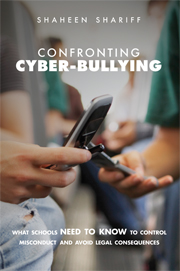 Confronting Cyber-Bullying
Confronting Cyber-Bullying Book contents
- Frontmatter
- Contents
- Figures
- Tables
- Preface
- Acknowledgments
- 1 Cyber Misconduct: Who Is Lord of the Bullies?
- 2 Profile of Traditional and Cyber-Bullying
- 3 Cyber Libel or Criminal Harassment: When Do Kids Cross the Line?
- 4 Student Free Expression: Do the Schoolhouse Gates Extend to Cyberspace?
- 5 Fostering Positive School Environments: Physical and Virtual
- 6 Censoring Cyberspace: Can Kids Be Controlled?
- 7 The Tragedy of the Commons: Lessons for Cyberspace?
- 8 Cyber Collaboration: Models for Critical Legal Pluralism in Teacher Education Programs
- Notes
- Cases
- Index
- References
4 - Student Free Expression: Do the Schoolhouse Gates Extend to Cyberspace?
Published online by Cambridge University Press: 02 July 2009
- Frontmatter
- Contents
- Figures
- Tables
- Preface
- Acknowledgments
- 1 Cyber Misconduct: Who Is Lord of the Bullies?
- 2 Profile of Traditional and Cyber-Bullying
- 3 Cyber Libel or Criminal Harassment: When Do Kids Cross the Line?
- 4 Student Free Expression: Do the Schoolhouse Gates Extend to Cyberspace?
- 5 Fostering Positive School Environments: Physical and Virtual
- 6 Censoring Cyberspace: Can Kids Be Controlled?
- 7 The Tragedy of the Commons: Lessons for Cyberspace?
- 8 Cyber Collaboration: Models for Critical Legal Pluralism in Teacher Education Programs
- Notes
- Cases
- Index
- References
Summary
[W]hile children assuredly do not shed their constitutional rights at the schoolhouse gate, the nature of those rights is what is appropriate for children in school.
Morse v. Frederick (2007), p. 15Disliking or being upset by the content of a student's speech is not an acceptable justification for limiting student speech…. Speech within the school that substantially interferes with school discipline may be limited. Individual student speech which is unpopular but does not substantially interfere with school discipline is entitled to protection.
Beussink v. Woodland R-IV School District (1988)INTRODUCTION
Chapter 3 engaged in a discussion about cultural differences in the way Asian countries are beginning to address students' cyber misconduct compared with countries in the West. I provided legal definitions for defamation and cyber libel and discussed North American and Australian jurisprudence on cyber libel in the context of a number of controversial case examples. Throughout I noted that despite the very public exposure such expressions receive, students maintain that schools have no right to intervene and argue that when they do, school authorities are intervening in private conversations among friends. Moreover, when students have been suspended for their online comments about teachers, some have protested and challenged their schools in court for infringing rights to freedom of expression.
In this chapter, I examine some of those challenges, to highlight what the courts have said about students' rights to free speech, limits on that speech, and limits on the rights and responsibilities of schools to intervene.
- Type
- Chapter
- Information
- Confronting Cyber-BullyingWhat Schools Need to Know to Control Misconduct and Avoid Legal Consequences, pp. 99 - 126Publisher: Cambridge University PressPrint publication year: 2009
References
- 3
- Cited by
